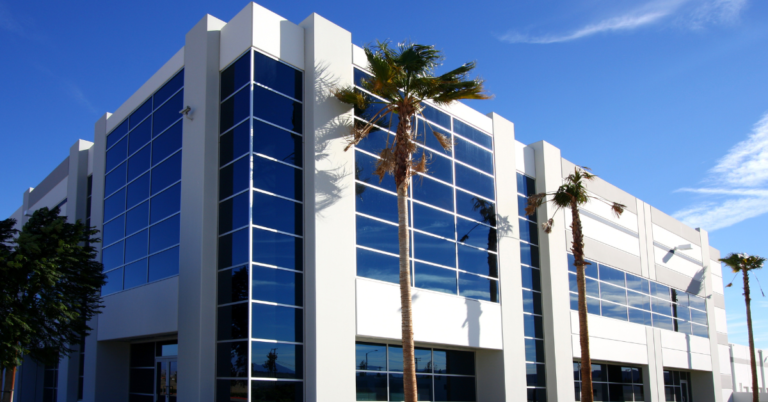What are Commercial Buildings?
So, what exactly constitutes a commercial building? Commercial buildings are structures designed solely for commercial or business purposes. These structures are meant to house shops, workplaces, retail establishments, or other commercial uses.
Commercial buildings, which can take many different forms and include office buildings, retail stores, hotels, warehouses, and other structures, are critical to the economy because they provide space for businesses to operate.
In this article, you will learn about “What are Commercial Buildings?” including their design and construction. You will also learn about key considerations such as location, design, amenities, sustainability, accessibility, security, and flexibility.
Continue reading to learn how commercial buildings benefit the economy by providing space for businesses to thrive.

Importance of Commercial Buildings
Commercial buildings are an essential component of modern society and have a significant economic impact. They provide areas for businesses to operate and provide numerous benefits to the commercial sector. Some of the key benefits of commercial buildings include:
Boosting Economic growth.
Commercial buildings provide space for businesses to operate, thereby promoting economic growth. Furthermore, they provide job opportunities, generate revenue through rent or sales, and boost economic activity in the surrounding areas.
Enhancing Business Operations
A commercial building is designed to meet the specific requirements of businesses by providing functional spaces for a variety of commercial activities. They provide amenities such as office space, meeting rooms, retail areas, and storage facilities to help businesses run efficiently and effectively.
Supporting Urbanisation
As cities expand and urbanize, commercial buildings play an important role in providing spaces for businesses to operate in urban areas. They help to create vibrant urban centers, attract investment, and contribute to the overall development of cities.
Facilitating Trade and Commerce
Commercial buildings, such as warehouses and distribution centers, facilitate the movement of goods and services, thereby promoting trade and commerce. They also provide space for storage, distribution, and logistics, allowing businesses to efficiently transport goods and meet customer demands.
Commercial Building Types
A commercial building can take a variety of forms, each designed to meet specific business needs. Some common types of commercial buildings are:
Office Buildings
Office buildings are designed to house businesses and provide space for office operations. They typically include individual offices, meeting rooms, common areas, and amenities like elevators and parking.
Retail Stores
Retail stores are commercial buildings that sell goods or services to customers. They come in a variety of forms, including stand-alone stores, shopping malls, and department stores, and are intended to provide attractive and functional spaces for retail businesses.
Hotels
Hotels are commercial structures designed to provide temporary lodging for travelers. They usually include guest rooms, restaurants, conference rooms, and other amenities for travelers.
Warehouses
Warehouses are commercial buildings used to store and distribute goods. They offer space for inventory management, order fulfillment, and logistics, and are available in a variety of sizes and configurations to meet various storage requirements.
Restaurants
Restaurants are commercial establishments that prepare and serve food to customers. They come in a variety of styles, including fast-food restaurants, cafes, and fine dining establishments, and are intended to provide functional and appealing dining environments.
Features of Commercial Buildings
Commercial buildings are built with specific features to meet the unique needs of businesses. Some key features of commercial buildings are:
Size and Scale
Commercial buildings come in a variety of sizes and scales, from small retail stores to large office towers and warehouses. The size and scale of a commercial building are determined by the type of business and the amount of available space.
Location
The location of the building is crucial to its success. As a result, commercial buildings are strategically placed in areas with high business activity, easy access to transportation, and visibility to potential customers. The location has a significant impact on the success of the businesses that operate in the building.
Design and Layout
The design and layout of commercial buildings are critical in creating functional spaces that meet the specific needs of businesses. As a result, the design takes into account factors such as space efficiency, traffic flow, accessibility, and aesthetics. Furthermore, the layout of commercial buildings is meticulously planned to maximise the use of space for various business activities, ensuring smooth operations.
Amenities
Commercial buildings frequently include amenities to improve the convenience and comfort of businesses and their customers. Therefore, features like elevators, parking lots, common areas, security systems, and energy-saving technologies may be included in amenities. The overall design and usability of the building are enhanced by these features.
Accessibility and Safety
Commercial buildings are made to adhere to safety regulations and building codes, as well as to be wheelchair accessible. Because of this, the building has accessibility features like lifts, ramps, and wider doorways to make sure that everyone can use it. To protect companies and their clients, safety features like security systems, emergency exits, and fire alarms are also included.
Construction of Commercial Buildings
Building a commercial structure is a complicated process that needs careful planning, coordination, and knowledge. Typically, the following steps are involved in the construction process:
Site Selection
The choice of a suitable location is the first stage in the construction phase. During the site selection process, variables like location, ease of access, zoning laws, and utilities that are available are taken into account.
Design and Planning
Second, the design and planning stage starts as soon as the site is chosen. A design that satisfies the needs of the company and conforms with building codes and regulations is created through collaboration between architects, engineers, and other design specialists. The structural details, mechanical and electrical systems, layout, and other specifications are all included in the design.
Permitting and Approvals
The relevant authorities must grant the required permissions and approvals before construction can start. Zoning permits, building codes, environmental restrictions, and other municipal or state mandates may fall under this category.
Construction
The construction phase starts after the design is complete and the necessary permits are obtained. This covers the actual construction of the commercial building, which includes clearing the site, laying the foundation, building the frame, installing the mechanical and electrical systems, and doing finishing touches like painting, staining, and interior design.
Inspection and Testing
In order to make sure the building is being built in accordance with the approved design and meets with building codes and regulations, inspections are carried out during the construction process. To guarantee the operation and security of mechanical and electrical systems, testing is also done on them.
Completion and Handover
Finally, the building is prepared for delivery to the business owner or operator upon completion of the construction and completion of all required testing and inspections. This includes obtaining all required occupancy permits and certificates of compliance.
Conclusion on Commercial Buildings
To summarize, commercial buildings are critical infrastructure that provide a space for various businesses to operate and thrive. They are carefully designed to take into account location, design and layout, amenities, accessibility, and safety.
A commercial building is built through a multi-step process that includes site selection, design and planning, permitting and approvals, construction, inspection and testing, and completion and handover.
Commercial building design considerations include space planning, aesthetics, sustainability, energy efficiency, accessibility, security, and flexibility. Additionally, compliance with building codes and regulations is required. Commercial buildings play an important role in the economy, providing space for businesses to grow and thrive.
Need assistance with the design and construction of a commercial building?
If you need help designing and building a new commercial building in Mysore, or if you need help re-designing or refurbishing an existing space, we can help with our retail, dental, and hospitality services, which include restaurants and pubs/bars.
We offer a complete package for your convenience, including design, project management, construction, and fit-out, as well as the provision and installation of furniture, lighting, air conditioning systems, and equipment.
Get in touch, and we’ll be very happy to talk you through the services we provide and offer our advice and expertise on commercial building construction.
Starting @ 1699/-* Including GST
Get Your Appointment Booked Today.
Best Residential & Commercial contractors in Mysore
Experience unmatched expertise and craftsmanship with Zenith Construction, recognized as the Best Residential & Commercial Contractors in Mysore.



